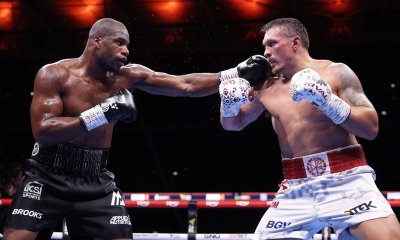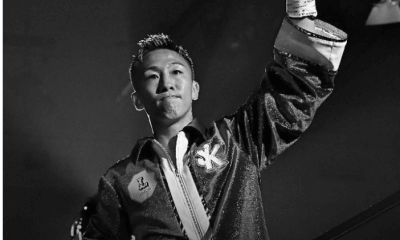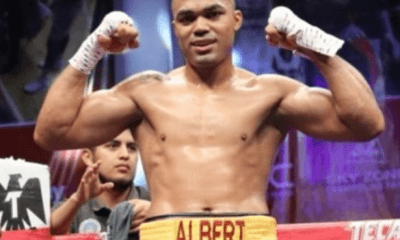Featured Articles
Boxing Odds and Ends: An Olympic Recap and a Repulsive Scorecard

The boxing competition at the Tokyo Olympics is over and for the fourth straight Olympiad the U.S. team was bereft of a gold medalist. But the U.S. men’s team emerged with three silvers which seemingly bodes well heading into the 2024 Summer Games in Paris. The three U.S. boxers that advanced to the finals were super heavyweight Richard Torrez Jr, lightweight Keyshawn Davis and featherweight Duke Ragan.
Davis and Ragan and middleweight Troy Isley were late additions to the five-member men’s team. When two Olympic qualifying tournaments were cancelled because of the Covid-19 pandemic, the International Olympic Committee Boxing Task Force adapted by concocting a formula that left Team USA no choice but to temporarily lift its rule whereby a boxer was disaffiliated once he or she turned pro. Presto, Davis (3-0 as a pro) Ragan (4-0) and Isley (2-0) were back in good standing. (Isley won his first fight in Tokyo, but lost his second. The other USA entrant, Delante “Tiger” Johnson, got as far as the quarterfinals before he was eliminated.)
In Tokyo, the Cubans reasserted their dominance, winning four gold medals and five medals overall. The Cuban gold medalists were heavyweight Julio la Cruz, light heavyweight Arlen Lopez, welterweight Roniel Iglesias, and lightweight Andy Cruz.
The 32-year-old Iglesias, who turned away Delante Johnson on his road to the finals, was competing in his fourth Olympiad. He won the gold in 2012 but came a cropper in Rio when he was knocked out in the second round by the eventual silver medalist, a fighter from Uzbekistan. The 23-year-old Cruz has been a thorn in the side of Keyshawn Davis who was the most heavily-touted member of the U.S. contingent. In Tokyo, Cruz and Davis were meeting for the fourth time and Davis has yet to beat him. As was true in their first encounter in Nicaragua, Keyshawn was on the wrong end of a split decision.
The big story coming out of the 2016 Games was the performance of the team from Uzbekistan in Rio. The Central Asian nation, home to roughly 32 million, captured seven medals: three gold, two silver, and two bronze.
This time around, only one Uzbek entrant captured a medal, but it was the gold and it was in the most prestigious weight class.
The match between Bakhodir Jalolov (pictured in the red) and Richard Torrez Jr was a rematch. They met in 2019 in Ekaterinburg, Russia, and Jalolov scored a brutal knockout, putting Torrez to sleep in the opening round.
Torrez won the first round of the rematch while sending the bout to the scorecards, but Jalolov, the much bigger man and a southpaw, not to mention undefeated (8-0, 8 KOs) at the professional level, is a beast and he pulled away to cop the decision. It was yet a valiant effort by Torrez Jr whose father advanced to the quarterfinals of the 1984 Olympic Trials while a senior in high school.
Hailing from the town of Tulare in America’s breadbasket, California’s San Joaquin Valley, Torrez Jr, 21, is not your conventional boxing personality. A fan of classical music – he has chosen Beethoven’s “Moonlight Sonata” for his motivational ring walk – Torrez was reportedly the valedictorian of his high school graduation class. (In 2019, we wrote that if Torrez were to win gold in Tokyo, he would command the highest signing bonus to turn pro of any boxer in the history of the sport.)
Heading into the tournament, Jalolov had the shortest odds of any boxer in the “future book.” A total of 276 boxers descended on Tokyo and he was the shortest favorite on the board. Interestingly, he would be the only top seed on the men’s side to win a gold medal. By contrast, all five of the women’s weight classes were won by the #1 seed.
The biggest upset was forged by 23-year-old Brazilian middleweight Hebert Sousa. He brought a 35-14 record to Tokyo per BoxRec and was fortunate to reach the finals after winning his first three matches by split decision. In the gold medal round, he was matched against #1 seed Oleksandr Khyzhniak who was expected to follow in the footsteps of countrymen Wladimir Klitschko, Vasiliy Lomachenko, and Oleksandr Usyk and bring home the gold for the Ukraine (Lomachenko did it twice).
Khyzhniak looked as if he was home free after dominating the first two frames. But midway through the third and final round, Sousa snatched victory from the jaws of defeat with a left uppercut that knocked the Ukrainian on the seat of his pants. Khyzhniak arose on unsteady legs and the referee stopped the fight.
Gloria Martinez-Rizzo
Eimantas Stanionis was dominating veteran Luis Collazo on Saturday night in the main event of the PBC show on FOX from the Minneapolis Armory when an accidental head butt terminated the contest in round four, resulting in a “no decision.” But all the talk the next day was about the bizarre decision rendered in the co-feature, a 12-round welterweight match between Gabriel Maestre and Mykal Fox.
Many of those tuning in on TV likely turned off the tube before the decision was announced. PBC’s unofficial scorer Marcos Villegos had it 119-109 for Fox, giving Maestre only one round. Why stick around to hear ring announcer Jimmy Lennon Jr. read the scores when the verdict is a foregone conclusion?
Ah, but as Yogi said, it’s never over until it’s over and, after all, this is boxing. All three judges gave the fight Maestre. They had him winning by scores of 114-113, 115-112, and 117-111. The 117-111 tally was submitted by Florida judge Gloria Martinez-Rizzo.
Prominent boxing writer Scott Christ called her scorecard repulsive. Tom Gray, the managing editor of The Ring magazine, called it one of the worst decisions that he had ever seen. “The verdict was so bad,” said Gray, “that it literally requires government intervention” (while acknowledging that there are more pressing concerns for our government during these messy times).
Martinez-Rizzo, a Miami-based Nicaraguan, has been a licensed boxing judge for 14 years but hasn’t been particularly active. One might ask what were her qualifications for the job.
BWAA vice-president Jake Donovan didn’t ask this question for his follow-up story for Boxing Scene but he provided the answer. Donovan noted that Ms. Martinez-Rizzo is married to longtime Florida fight facilitator Ricardo Rizzo. A google search finds Ricardo Rizzo in Panama City in 2015 paying his respects at the memorial service for WBA president Gilberto Mendoza Sr who had passed away at age 75. Mendoza’s son of the same name inherited his father’s post and still runs the organization. The Mendozas were born in Venezuela and the WBA was headquartered there in Caracas before the firm relocated to Panama City.
About Gabriel Maestre, the recipient of the gift decision: He represented Venezuela in the 2012 and 2016 Olympics. Now 34 years old, he was 3-0 as a pro heading into his match with Mykal Fox which was his U.S. debut.
True, Maestre was a two-time Olympian, but a closer look at his amateur record, 75-34 per BoxRec including a 9-8 mark in the semi-pro World Series of Boxing, suggests that he wasn’t going to be all that great as a pro.
So how is it that the WBA had him ranked #4 at welterweight after only three pro fights? Go ask Gilbert Mendoza Jr but be certain to get fumigated after leaving the interview.
P.S. – It’s doubtful that Gloria Martinez-Rizzo will ever judge another fight and that has nothing to do with her actions in Minneapolis. It has been discovered that she has a history of racist tweets including calling former first lady Michelle Obama a “monkey face.” Her twitter page has since been deleted.
Check out more boxing news on video at the Boxing Channel
To comment on this story in the Fight Forum CLICK HERE
-

 Featured Articles3 weeks ago
Featured Articles3 weeks agoThe Hauser Report: Zayas-Garcia, Pacquiao, Usyk, and the NYSAC
-

 Featured Articles2 weeks ago
Featured Articles2 weeks agoOscar Duarte and Regis Prograis Prevail on an Action-Packed Fight Card in Chicago
-

 Featured Articles1 week ago
Featured Articles1 week agoThe Hauser Report: Cinematic and Literary Notes
-

 Book Review5 days ago
Book Review5 days agoMark Kriegel’s New Book About Mike Tyson is a Must-Read
-

 Featured Articles4 weeks ago
Featured Articles4 weeks agoManny Pacquiao and Mario Barrios Fight to a Draw; Fundora stops Tim Tszyu
-

 Featured Articles4 weeks ago
Featured Articles4 weeks agoArne’s Almanac: Pacquiao-Barrios Redux
-

 Featured Articles3 weeks ago
Featured Articles3 weeks agoRemembering Dwight Muhammad Qawi (1953-2025) and his Triumphant Return to Prison
-

 Featured Articles4 weeks ago
Featured Articles4 weeks agoOleksandr Usyk Continues to Amaze; KOs Daniel Dubois in 5 One-Sided Rounds


















